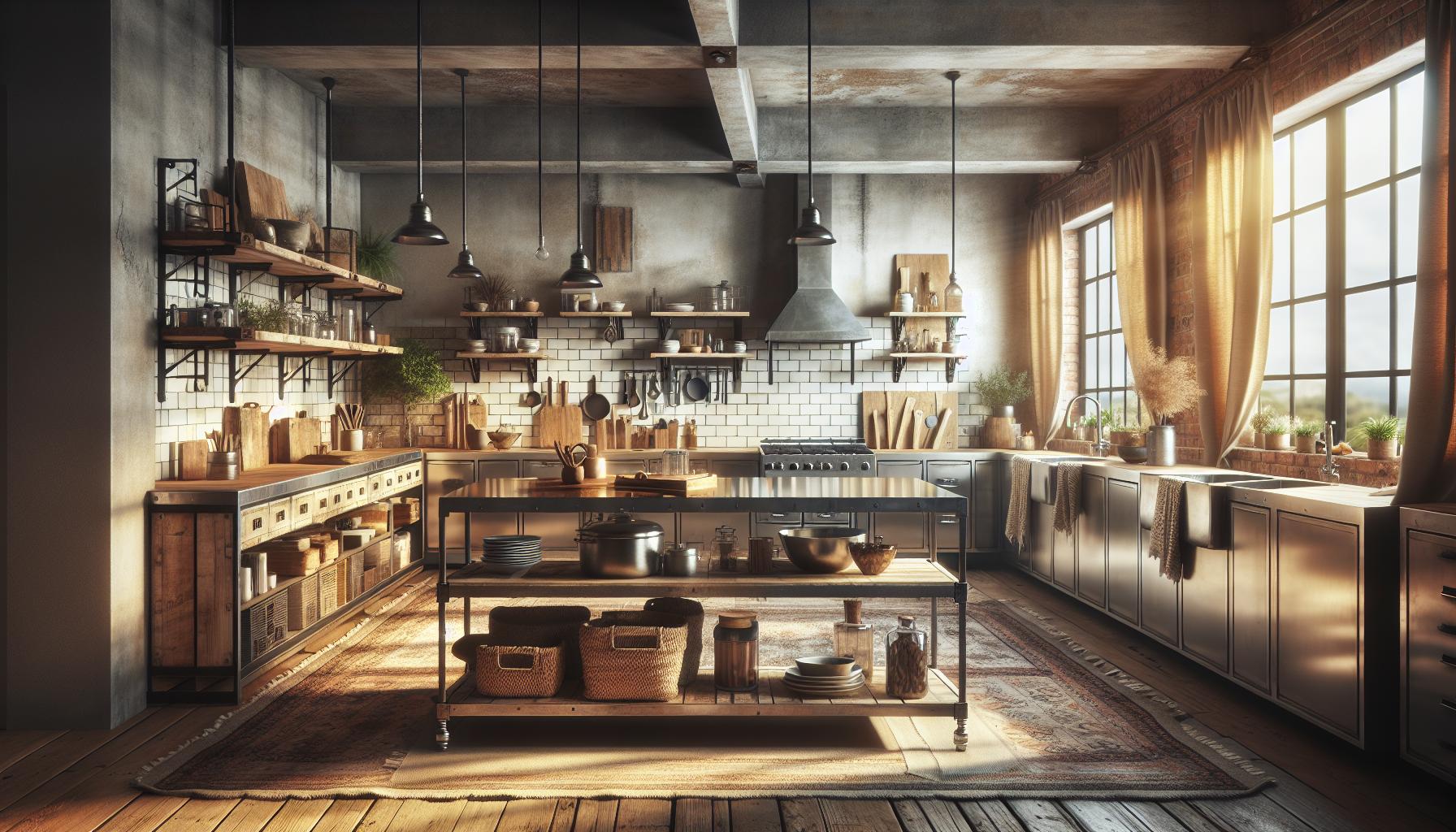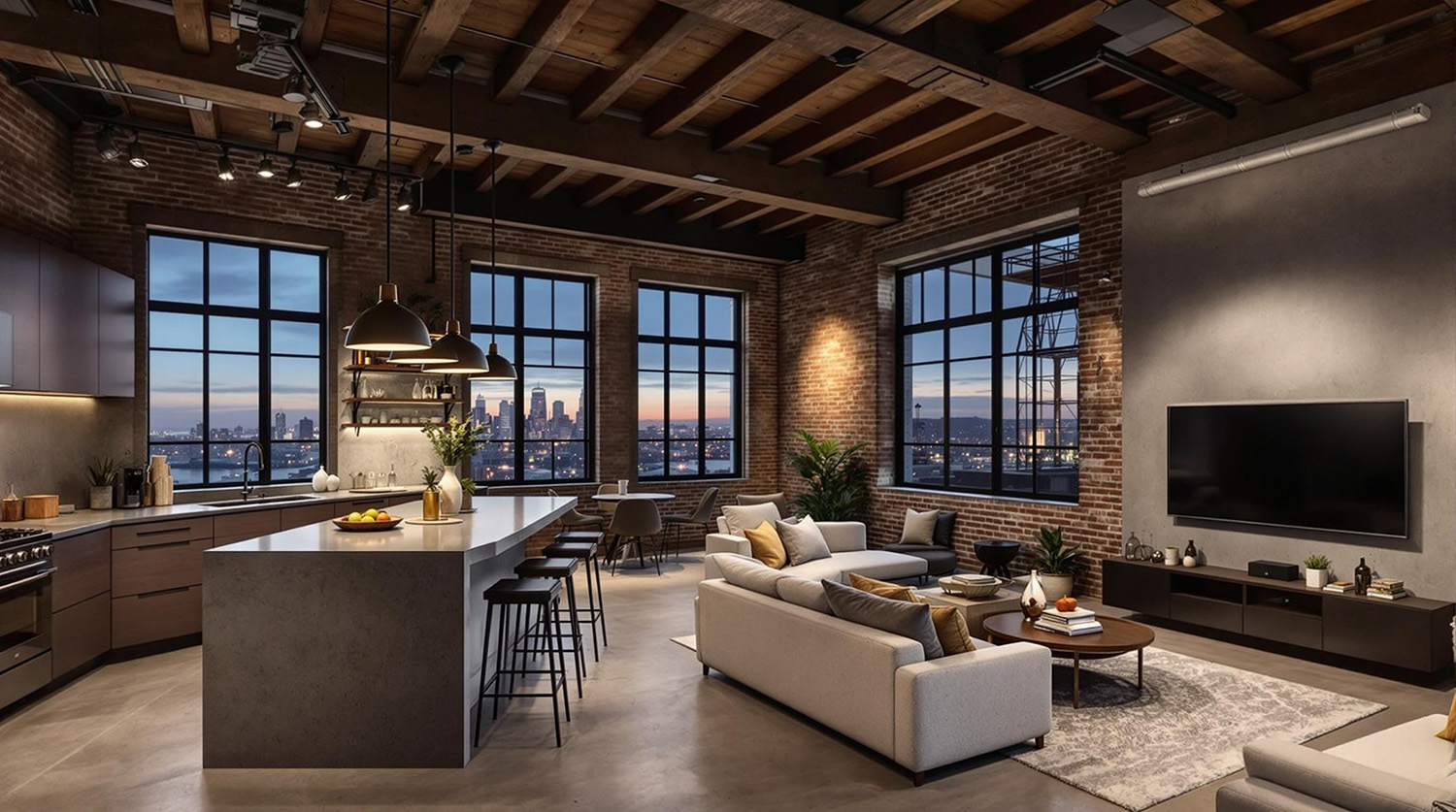Industrial interior design brings the rugged charm of old factories and warehouses into your home, blending raw materials with modern comfort. Think exposed brick walls, steel beams, and concrete floors: elements that celebrate a building’s history while creating a bold, authentic vibe.
By mixing in warm lighting, reclaimed wood, and soft textiles, you can balance that industrial edge with a cozy, inviting feel.
But don’t worry, this style isn’t all cold and stark.
High ceilings, large steel-framed windows, and open layouts are hallmarks of this design, flooding your space with natural light and a sense of freedom. Whether it’s an L-shaped kitchen island or a living room with visible ductwork, industrial design encourages a communal, lived-in atmosphere.
Let’s explore how to make it work for you.
Ready to bring this unique style into your home?
Modern Industrial Design: Balancing Raw Aesthetics with Inviting Comfort
Modern industrial design blends the rugged charm of historical industrial spaces with refined, livable elements. By combining raw materials and utilitarian features with cozy touches, this style creates spaces that are both striking and welcoming.
Defining Characteristics of Industrial Design
Industrial interior design celebrates authenticity through its bold, unadorned elements. It’s a style that thrives on contrasts, pairing raw, unfinished textures with soft, inviting details to create a balanced and functional space.
Exposed Structural Elements
Exposed brick walls, concrete floors, and visible ductwork are hallmarks of industrial home designs.
These features highlight the building’s history and structural integrity, giving your space a raw, honest feel. For example, steel beams and unfinished ceilings can add an urban edge while maintaining a sense of openness.
Neutral and Monochromatic Palettes
Industrial aesthetics often rely on muted color schemes dominated by grays, blacks, and whites. Earthy tones like rust or ochre occasionally appear to add warmth.
This palette lets the textures of materials, like the roughness of reclaimed wood or the sheen of steel, take center stage.
Repurposed and Sustainable Materials
Sustainability is a key aspect of industrial design. Reclaimed wood, recycled metals, and salvaged fixtures not only reduce environmental impact but also infuse spaces with character.
Think barn wood cabinetry or dining tables crafted from factory floorboards; these elements add history and charm to your home.
Open Floor Plans and Natural Light
Industrial design favors expansive layouts with high ceilings and large windows.
Steel-framed casement windows flood interiors with natural light, while open-concept kitchens and living areas foster a communal feel. This layout mimics the airy, unobstructed spaces of old factories, making it ideal for social gatherings and everyday living.
Balancing Industrial Edge with Comfort

Industrial design doesn’t have to feel cold or unwelcoming. By blending raw materials with cozy textures and organic elements, you can create a space that’s both striking and comfortable.
Industrial Kitchens: Functionality Meets Warmth
Industrial kitchens shine with stainless steel countertops, exposed brick backsplashes, and open shelving with metal brackets. These elements nod to the style’s utilitarian roots.
To soften the look, add reclaimed wood accents like floating shelves or butcher-block islands. Pairing raw metals with warm textiles or wood creates a balance that’s both functional and inviting.
Industrial Bathrooms: Urban Spa Retreats
Transform your bathroom into a spa-like retreat with bold industrial materials like concrete freestanding tubs and blackened steel mirrors.
Add greenery like potted ferns or eucalyptus, and layer in luxe textiles like Turkish cotton towels for a cozy, urban vibe.
Balance these with organic accents, such as teak benches or reclaimed wood vanities.
Industrial Living Rooms: Cozy Urban Lofts
In industrial living rooms, mix hard and soft furnishings to strike the perfect balance.
Exposed brick walls and metal light fixtures set the tone, while plush sofas, wool rugs, and reclaimed wood coffee tables add warmth. High ceilings and large windows flood the space with natural light, creating an airy yet cozy atmosphere ideal for social gatherings.
The Evolution of Industrial Design
Industrial interior design has come a long way from its factory roots, evolving into a style that’s both bold and inviting. It’s all about embracing raw materials while creating spaces that feel warm and lived-in.
By blending rugged textures with modern comforts, you can craft a home that’s uniquely yours.
This style isn’t just about aesthetics; it’s a celebration of authenticity and sustainability. With its focus on repurposed materials and open layouts, industrial design offers a fresh way to make your space functional and stylish.
Whether you’re drawn to exposed brick or sleek steel, there’s room to make it your own.
So why not take the plunge? With a little creativity, you can transform your home into a modern industrial haven that’s as cozy as it is cool.

